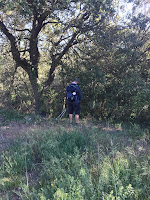Breakfast pitcher holding fresh, cold milk.
At Tio Pepe's bar, starting at 8:30 AM.
Ready to hit the road, leaving Mazarife behind.
Having betrayed their owner, they were hung!
One last glance at our digs last night.
Can you see Dave's pink towel on the line?
Can you see it now...and Mike's yellow one?
There's even a movie!
Cute couple from New Zealand.
Still in love after 30 years.
Held hands for five miles.
Dave walking the trail, heading for Hospital.
(Hospital de Obdigo, that is.)
Poppies border the trail and ditch.
Dave's story (below) relates to this video.
Dave weighs himself on the truck scales.
Nope, no weight loss yet!
View of the bridge, entering Hospital.
Bridge and the city beyond. Wonderful scene.
Another angle. Can't choose, so you get both.
Two non-jousting pilgrims.
Good-looking rascals.
Coming into town over the bridge.
Ready for our siesta.
Hospital de Orbigo. Banners still up from a
jousting tournament over the past two days.
(No wonder the town is named Hospital!)
Site of the tournament that we barely missed.
Mike wanted to take part but was "speared."
Tournament description in Spanish.
Close-up of tournament description.
Still in Spanish.
Canal at the "old town" end of the bridge.
Bridge and fairgrounds.
Iglesia de San Juan Bautista - church tower.
Fuller shot of San Juan Bautista.
Tomb of Don Suera de Quinones.
(Mike's story about him below)
Tomorrow we travel 13 miles to Astorga,
the town with Mike's son-in-law's last name!
A story from Dave:
We have now left the Meseta and entered the Paramo. The Spanish dictionary defines "paramo" as a high desert plateau, barren for miles; a bleak wasteland. As we walked through the Paramo today and looked around, it did seem that the land was drier than before, but there were many fields of wheat and corn and occasionally trees to block the wind. It certainly didn't look anything like a wasteland to me. That's because there were many irrigation canals surrounding the fields, all filled with flowing, clear water. The irrigation system came about because of a woman and the man who loved her.
Here is their story: A young suitor fell in love with the beautiful Arabian princess, Zaida, whose father lived in this area in the 11th century. He agreed to the marriage of his daughter, but only on condition that the waters of the Orbigo River would flow past his house. The young suitor set about constructing a dam (Presa Cerrajera) to divert the waters. His ingenuity won Zaida for himself and the Paramo's wonderful irrigation system for future generations! This is a beautiful and productive land today, a barren wasteland no more––all because of a man who moved heaven and earth (or in this case, water) to show his love for a woman. By the way, I didn't have to build a dam to get permission to marry Sue, but I would have!
 |
| Dave near irrigation ditch. |
A story from Mike:
Today we came into the town of Hospital de Orbigo, celebrated for its jousting contests. Puente de Orbigo, one of the longest and best-preserved medieval bridges in Spain, was built in the 13th century and still leads the way for pilgrims going to Santiago de Compostela. Dave and I were happy to have a chance to cross it today because, in the past, not everyone was so lucky! Years ago, a young knight from Leon (Don Suero) was scorned by a beautiful lady (Dona Leonor) who rejected his love. Humiliated, he proclaimed himself a "prisoner of love" and placed an iron collar around his neck. He then stood on the Puente de Orbigo and challenged all the knights in Europe to a jousting contest, defending the bridge (and presumably his honor) against any and all comers. He vowed to win every encounter, continuing his pursuit until he had broken 300 lances. Then and only then would he remove the collar, having earned his freedom from the bonds of unrequited love. Knights came from all over to beat him, but Don Suero managed to defend the bridge for an entire month until the required 300 lances were broken. Vindicated, he not only removed the iron collar but returned to Santiago with his friends to offer thanks for escaping his unreturned devotion to the young lady and restoring his honor.
This tale of Don Suero got me thinking. We all have jousting tournaments of the soul, battles of honor we must fight within ourselves at times. When we are unseated, getting up again makes all the difference, as does fighting to the end for victory. Are you familiar with that old Japanese saying, "Fall down seven times, stand up eight?" It speaks to resilience and perseverance, just as the Camino does. Dave and I face a harder climb tomorrow, with more beauty but also more ups and downs. To be honest, we're a little concerned about it, and our feet are downright anxious! Happily, we will wear no iron collars, but if we should slip or stumble a bit on the way, our resolve is to rise quickly and win the battle. Don Suero broke 300 lances in a month; we can break 13 hilly miles in one day. Buen Camino, friends!
Puente de Orbigo aka Paso Honroso
in view of the jousting tournament story.
Loose translation: "The Way to Honor."
Click below to support suicide prevention
and mental health, the causes Mike and Dave
are championing with their walk.

























Once again I love seeing the red poppies. They are beautiful flowers.
ReplyDeleteIt is super weird to see bishop with a beard.
I love hearing the Camino stories. Bringing water to a waste land for love. Defending one's honor is another great story.
Please walk safe and follow through. I'm always thinking of you two. You are great examples.